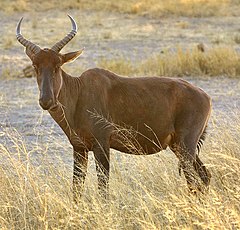Sasebi
| Damaliscus[1] | |||
| Sclater & Thomas, 1894[2] | |||
 Przedstawiciel rodzaju – sasebi właściwy (Damaliscus lunatus) | |||
| Systematyka | |||
| Domena | |||
|---|---|---|---|
| Królestwo | |||
| Gromada | |||
| Podgromada | |||
| Infragromada | |||
| Rząd | |||
| Podrząd | |||
| Infrarząd | |||
| Rodzina | |||
| Podrodzina | |||
| Plemię | |||
| Rodzaj | sasebi | ||
| Typ nomenklatoryczny | |||
Antilope pygargus Pallas, 1767 | |||
| Synonimy | |||
| Gatunki | |||
| |||
Sasebi[4] (Damaliscus) – rodzaj ssaka z podrodziny antylop (Antilopinae) w obrębie rodziny wołowatych (Bovidae).
Zasięg występowania
Rodzaj obejmuje gatunki zamieszkujące Afrykę[5][6][7].
Morfologia
Długość ciała 140–268 cm, ogona 30–45 cm, wysokość w kłębie 90–134 cm; masa ciała samic 56–139 kg, samców 68–168 kg[6].
Systematyka
- Damalis: gr. δαμαλις damalis „młoda krowa, jałówka”[8]. Gatunek typowy: Antilope lunata Burchell, 1823; nie Damalis C.H. Smith, 1827; młodszy homonim Damalis Fabricius, 1805 (Diptera).
- Damaliscus: rodzaj Damalis C.H. Smith, 1827 (bawolec); łac. przyrostek zdrabniający iscus[8].
Podział systematyczny
Do rodzaju sasebi zalicza się następujące występujące w czasach historycznych gatunki[5][4]:
- Damaliscus pygargus (Pallas, 1767) – sasebi przylądkowy
- Damaliscus phillipsi Harper, 1939 – sasebi zuluski
- Damaliscus lunatus (Burchell, 1823) – sasebi właściwy
- Damaliscus superstes Cotterill, 2003 – sasebi zambijski
- Damaliscus korrigum (Ogilby, 1837) – sasebi sawannowy
- Damaliscus tiang (Heuglin, 1863) – sasebi środkowoafrykański
- Damaliscus ugandae Blaine, 1914
- Damaliscus eurus Blaine, 1914
- Damaliscus jimela (Matschie, 1892)
- Damaliscus selousi Lydekker, 1907 – gatunek wymarły.
- Damaliscus topi Blaine, 1914 – sasebi nadbrzeżny
Opisano również kilka gatunków wymarłych w czasach prehistorycznych:
- Damaliscus ademassui Vrba, 1997[9] (późny pliocen)
- Damaliscus agelaius A.W. Gentry & A. Gentry, 1978[10] (późny pliocen–środkowy plejstocen)
- Damaliscus cuiculi Arambourg, 1979[11] (późny pliocen)
- Damaliscus eppsi Harris, 1991[12] (późny pliocen–wczesny plejstocen)
- Damaliscus gentryi Vrba, 1977[13] (późny pliocen)
- Damaliscus hypsodon Faith, Potts, Plummer, Bishop, Marean & Tryon, 2012[14] (środkowy i późny plejstocen)
- Damaliscus niro (Hopwood, 1936)[15] (środkowy plejstocen)
- Damaliscus strepsiceras Geraads, 2004[16] (wczesny plejstocen)
Przypisy
- ↑ Damaliscus, [w:] Integrated Taxonomic Information System [online] (ang.).
- ↑ P.L. Sclater & O. Thomas: The book of antelopes. Cz. 1. London: R.H. Porter, 1894, s. 3, 51. (ang.).
- ↑ J.E. Gray. On the arrangement of the hollow-horned ruminants (Bovidæ). „The Annals and Magazine of Natural History”. 18, s. 233, 1846. (ang.).
- ↑ a b W. Cichocki, A. Ważna, J. Cichocki, E. Rajska-Jurgiel, A. Jasiński, W. Bogdanowicz: Polskie nazewnictwo ssaków świata. Warszawa: Muzeum i Instytut Zoologii PAN, 2015, s. 177. ISBN 978-83-88147-15-9. (pol. • ang.).
- ↑ a b C.J. Burgin, D.E. Wilson, R.A. Mittermeier, A.B. Rylands, T.E. Lacher & W. Sechrest: Illustrated Checklist of the Mammals of the World. Cz. 2: Eulipotyphla to Carnivora. Barcelona: Lynx Edicions, 2020, s. 352–354. ISBN 978-84-16728-35-0. (ang.).
- ↑ a b C. Groves, D. Leslie, B. Huffman, R. Valdez, K. Habibi, P. Weinberg, J. Burton, P. Jarman, W. Robichaud: Family Bovidae (Hollow-horned Ruminants). W: D.E. Wilson, R.A. Mittermeier (red. red.): Handbook of the Mammals of the World. Cz. 2: Hoofed Mammals. Barcelona: Lynx Edicions, 2011, s. 701–704. ISBN 978-84-96553-77-4. (ang.).
- ↑ D.E. Wilson & D.M. Reeder (red. red.): Genus Damaliscus. [w:] Mammal Species of the World. A Taxonomic and Geographic Reference (Wyd. 3) [on-line]. Johns Hopkins University Press, 2005. [dostęp 2021-05-02]. (ang.).
- ↑ a b T.S. Palmer. Index Generum Mammalium: a List of the Genera and Families of Mammals. „North American Fauna”. 23, s. 215–216, 1904. (ang.).
- ↑ E.S. Vrba. New fossils of Alcelaphini and Caprinae (Bovidae: Mammalia) from Awash, Ethiopia, and phylogenetic analysis of Alcelaphini. „Palaeontologia africana”. 34, s. 170, 1997. (ang.).
- ↑ A.W. Gentry & A. Gentry. Fossil Bovidae (Mammalia) of Olduvai Gorge, Tanzania, Part 1. „Bulletin of the British Museum (Natural History) Geology”. 29, s. 402, 1978. (ang.).
- ↑ C. Arambourg: Vertébrés villafranchiens d’Afrique du Nord (artiodactyles, carnivores, primates, reptiles, oiseaux). Paris: Fondation Singer-Polignac, 1979, s. 84. ISBN 978-29-00-92704-5. (fr.).
- ↑ J.M. Harris: Family Bovidae. W: J.M. Harris (red.): Koobi fora research project. Cz. 3: The Fossil Ungulates: Geology, Fossil Artiodactyls, and Palaeoenvironments. Oxford: Clarendon Press, 1991, s. 195. ISBN 0-19-857399-5. (ang.).
- ↑ E.S. Vrba. New species of Parmularius Hopwood AND Damaliscus Sclater and Thomas (Alcelaphini, Bovidae, Mammalia) from Makapansgat, and comments on faunal chronological correlation. „Palaeontologia africana”. 20, s. 143, 1977. (ang.).
- ↑ J.T. Faith, R. Potts, T.W. Plummer, L.C. Bishop, C.W. Marean & C.A. Tryon. New perspectives on middle Pleistocene change in the large mammal faunas of East Africa: Damaliscus hypsodon sp. nov. (Mammalia, Artiodactyla) from Lainyamok, Kenya. „Palaeogeography, Palaeoclimatology, Palaeoecology”. 361–362, s. 85, 2012. DOI: 10.1016/j.palaeo.2012.08.005. (ang.).
- ↑ A.T. Hopwood. New and little-known fossil mammals from the Pleistocene of Kenya Colony and Tanganyika Territory—I. „The Annals and Magazine of Natural History”. Tenth series. 17 (102), s. 640, 1936. DOI: 10.1080/00222933608655164. (ang.).
- ↑ D. Geraads, V. Eisenmann & G. Petter: The large mammal fauna of the Oldowan sites of Melka Kunture. W: J. Chavaillon & M. Piperno: Studies on the Early Paleolithic site of Melka Kunture, Ethiopia. Florence: Istituto Italiano di Preistoria e Protostoria, 2004, s. 188. ISBN 978-88-6045-015-9. (ang.).
Media użyte na tej stronie
Autor: (of code) -xfi-, Licencja: CC BY-SA 3.0
The Wikispecies logo created by Zephram Stark based on a concept design by Jeremykemp.

